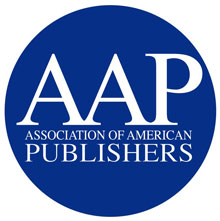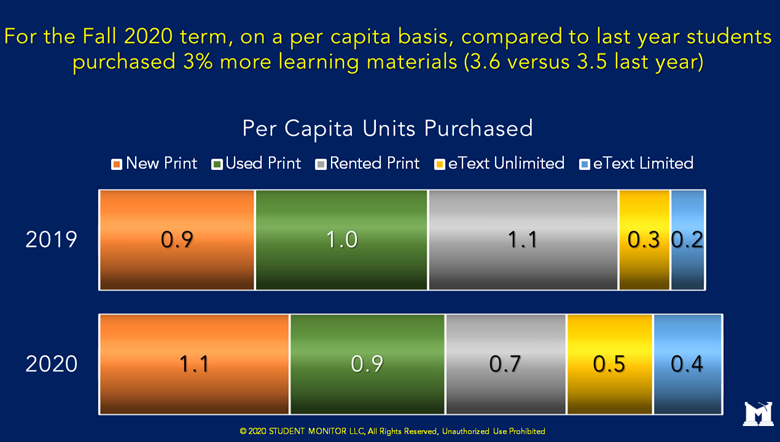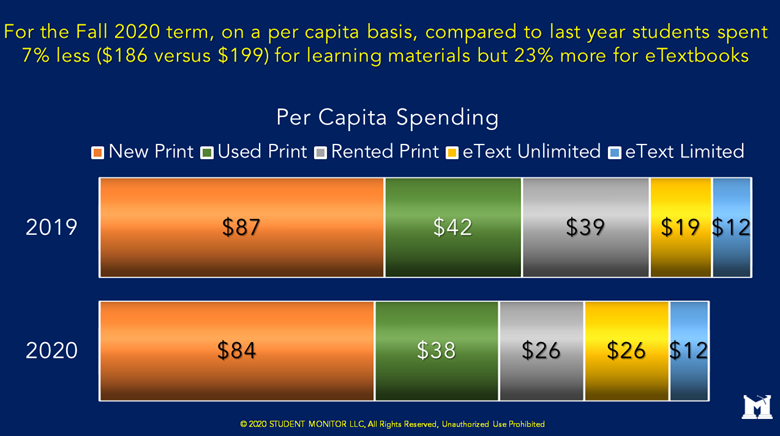November 5, 2020
Student Monitor Fall 2020 Preview: Multi-Year Decline in Student Spending on College Course Materials Continues

Distance Learning Results in Rise in Consumption of eTextbooks
Average student spending on college textbooks and course materials continued to decline during the fall semester of 2020, dropping 7% compared to the same term last year, according to a special preview of the latest data from independent research firm Student Monitor. A high-level version of Student Monitor’s Fall 2020 report is due out in November, followed by the full report in December.
“We are pleased to once again partner with Student Monitor to offer a sneak peek of its Fall 2020 report, which reaffirms the incredible array of options that students and college administrators have today to access course materials and improve learning outcomes,” said Kelly L. Denson, Vice President of Education Policy and Programs at the Association of American Publishers. “The consistent decline in student spending on textbooks and other learning materials is a clear illustration of education publishers’ longstanding commitment to affordability initiatives that put students and educators first.”

According to Student Monitor, average student spending on course materials was $186 for the Fall 2020 semester, a decline of 7% when compared to the Fall 2019 spend of $199. The decline was primarily the result of a shift in spending from print textbooks to lower-cost eTextbooks. At the same time the number of units purchased or rented increased by 3%, including a 23% increase in spending on eTextbooks.
“During the fall semester of 2020, distance learning drove widespread adoption of less expensive eTextbooks in both sales and rentals – including through subscription models – leading to a 7% decline in spending as compared to the same period last year,” commented Eric Weil, Managing Partner, Student Monitor. “At the same time, the volume of sales increased by 3%, which means that students are buying more course materials than last year, but they’re purchasing less expensive digital alternatives.”

Decline in Student Spending is Multi-Year Trend According to College Board, Student Watch and Student Monitor
Student Monitor’s Fall 2020 findings reflect a multi-year trend of declining student spending on course materials. The annual decline was most recently reflected in the College Board’s October release of Trends in College Pricing and Student Aid 2020, which brought important clarity to the amount students actually spend on course materials, finding an average of $410 per year. The annual figure also closely mirrors annual data from both Student Monitor, and the National Association of College Stores’ research arm, Student Watch.
Choice
During the Fall 2020 semester, Student Monitor found that spending on course materials was distributed over a wide range of options. Out of the $186 of average student spending during the semester the organization found that an average of $84 was spent on new, print textbooks; $38 on used, print textbooks; $26 on rented, print textbooks; $26 on eTextbooks with unlimited use; and $12 on eTextbooks with limited-time use. With the exception of eTextbooks each of these categories saw a decline in average spending compared to the 2019 fall term.
“As a result of the pandemic we saw a notable increase in the consumption of eTextbooks,” Weil added. “But even during the pandemic students are taking full advantage of the wide array of options that are available including a growing use of subscription models. Nobody buys 100% new; nobody buys 100% used; nobody rents 100%.”
Options
The ongoing decline in spending on course materials reflects the fact that students are taking full advantage of the new, cost-effective options that publishers have made available, including initiatives such as Inclusive Access, which provides students with course materials on the first day of class at a reduced cost. Other options like subscription models provide unlimited access to a range of textbooks, open course materials, online homework access codes and study guides, all for one price.
Student Monitor Methodology
The Student Monitor findings are the result of hour-long, one-on-one, on campus intercept interviews conducted among 1,200 four-year, full time undergraduates attending 100 representative colleges and universities. Unlike previous years, due to the COVID-19 epidemic many of the Fall 2020 interviews were conducted remotely.
# # #
About AAP
The Association of American Publishers represents the leading book, journal, and education publishers in the United States on matters of law and policy, advocating for outcomes that incentivize the publication of creative expression, professional content, and learning solutions. As essential participants in local markets and the global economy, our members invest in and inspire the exchange of ideas, transforming the world we live in one word at a time. Find us online at https://publishers.org or on twitter at @AmericanPublish.
